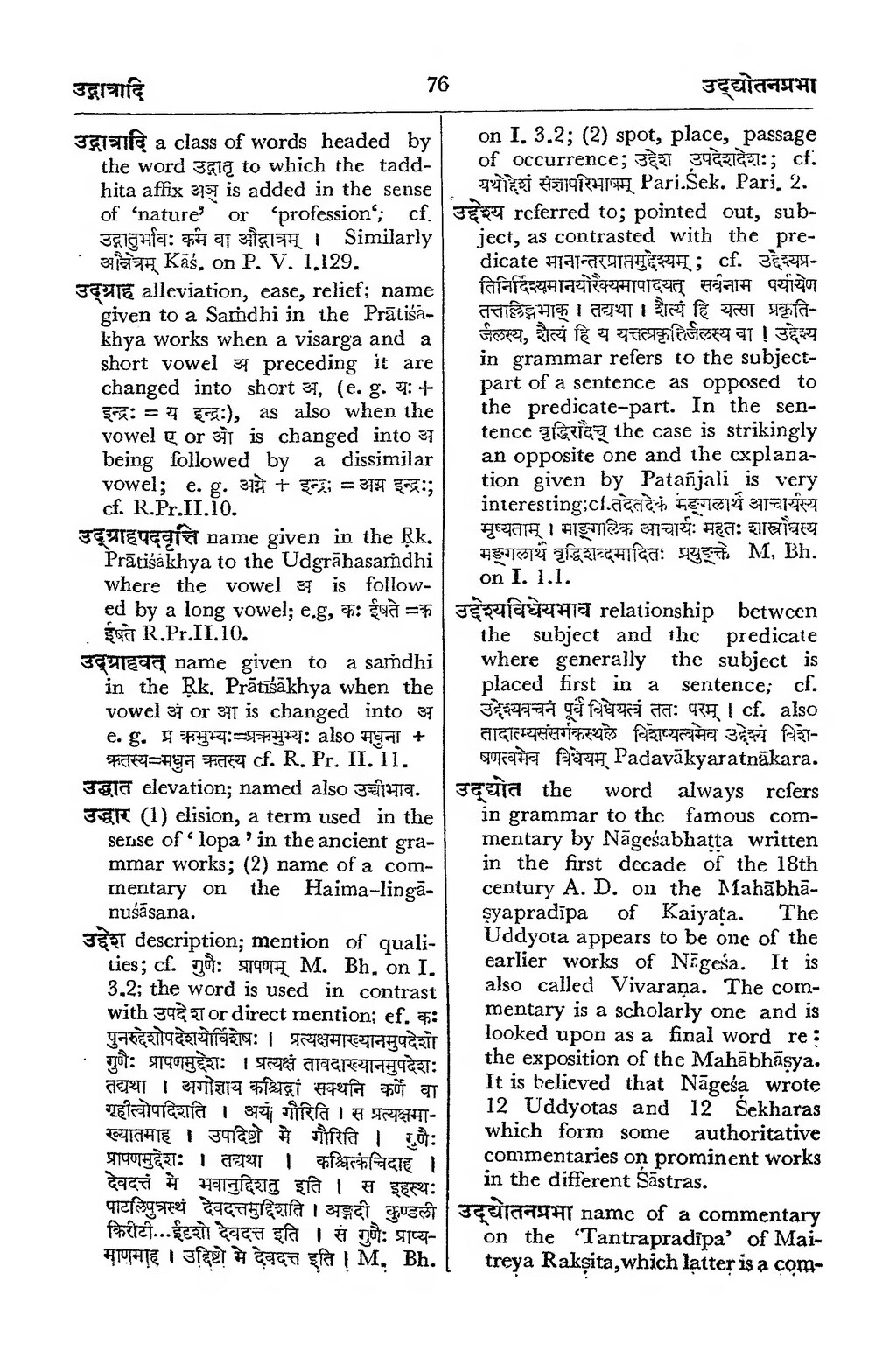उद्गात्रादि a class of words headed by the word उद्गातृ to which the tadd- hita affix अञ् is added in the sense of 'nature' or 'profession'; cf. उद्गातुर्भावः कर्म वा औद्गात्रम् । Similarly औन्नेत्रम् Kāś. on P. V. 1.129. उद्ग्राह alleviation, ease, relief; name given to a Saṁdhi in the Prātiśā- khya works when a visarga and a short vowel अ preceding it are changed into short अ, (e. g. यः + इन्द्र: = य इन्द्र:), as also when the vowel ए or ओ is changed into अ being followed by a dissimilar vowel; e. g. अग्ने + इन्द्रः = अग्न इन्द्रः; cf. R.Pr.II.10. उद्ग्राहपदवृत्ति name given in the Rk. Prātiśākhya to the Udgrāhasaṁdhi where the vowel अ is follow- ed by a long vowel; e.g, कः ईषते =क ईषते R.Pr.II.10. उद्ग्राहवत् name given to a saṁdhi in the Rk. Prātiśākhya when the vowel अ or अा is changed into अ e. g. प्र ऋभुभ्यः=प्रऋभुभ्य: also मधुना + ऋतस्य=मधुन ऋतस्य cf. R. Pr. II. 11. उद्धात elevation; named also उच्चीभाव. उद्धार (1) elision, a term used in the sense of 'lopa' in the ancient gra- mmar works; (2) name of a com- mentary on the Haima-liṅgā- nuśāsana. उद्देश description; mention of quali- ties; cf. गुणैः प्रापणम् M. Bh.on I. 3.2: the word is used in contrast with उपदेश or direct mention; cf. कः पुनुरुद्देशोपदेशयोर्विशेषः । प्रत्यक्षमाख्यानमुपदेशो गुणैः प्रापणमुद्देशः । प्रत्यक्षं तावदाख्यानमुपदेशः तद्यथा । अगोज्ञाय कश्चिद्गां सक्थनि कर्णे वा गृहीत्वोपदिशति । अयं गौरिति । स प्रत्यक्षमा- ख्यातमाह । उपदिष्टो मे गौरिति । गुणैः प्रापणमुद्देशः । तद्यथा । कश्चित्कंचिदाह । देवदत्तं मे भवानुद्दिशतु इति । स इहस्थः पाटलिपुत्रस्थं देवदत्तमुद्दिशति । अङ्गदी कुण्डली किरीटी...ईदृशो देवदत्त इति । स गुणैः प्राप्य- माणमाह । उद्दिष्टो मे दवदत्त इति । M. Bh. |
on I. 3.2; (2) spot, place, passage of occurrence: उद्देश उपदेशदेशः; cf. यथोद्देशं संज्ञापरिभाषम् Pari.Śek. Pari. 2. उद्देश्य referred to; pointed out, sub- ject, as contrasted with the pre- dicate मानान्तरप्राप्तमुद्देश्यम् ; cf. उद्दश्यप्र- तिनिर्दिश्यमानयोरैक्यमापद्यत् सर्वनाम पर्यायेण तत्तल्लिङभाक् । तद्यथा | शैत्यं हि यत्सा प्रकृति- र्जलस्य, शैत्यं हि य यत्तत्प्रकृतिर्जलस्य वा । उद्देश्य in grammar refers to the subject- part of a sentence as opposed to the predicate-part. In the sen- tence वृद्धिरादैच् the case is strikingly an opposite one and the explana- tion given by Patañjali is very interesting;cf. तदेतदेकं मङ्गलार्थं आचार्यस्य मृष्यताम् । माङ्गलिक अाचार्यः महतः शास्त्रौघस्य मङ्गलार्थं वृद्धिशब्दमादितः प्रयुङ्कते, M. Bh. on I. 1.1. उद्देश्यविधेयभाव relationship between the subject and the predicate where generally the subject is placed first in a sentence; cf. उद्देश्यवचनं पूर्वं विधेयत्वं ततः परम् । cf. also तादात्म्यसंसर्गकस्थले विशेष्यत्वमेव उद्देश्यं विशे- षणत्वमेव विधेयम् Padavākyaratnākara. उद्द्योत the word always refers in grammar to the famous com- mentary by Nāgeśabhaṭṭa written in the first decade of the 18th century A. D. om the Mahābhā- ṣyapradīpa of Kaiyaṭa. The Uddyota appears to be one of the earlier works of Nāgeśa. It is also called Vivaraṇa. The com- mentary is a scholarly one and is looked upon as a final word re : the exposition of the Mahābhāṣya. It is believed that Nāgeśa wrote 12 Uddyotas and 12 Śekharas which form some authoritative commentaries on prominent works in the different Śāstras. उद्द्योतनप्रभा name of a commentary on the 'Tantrapradipa' of Mai- treya Rakṣita,which latter is a com- |
पृष्ठम्:ADictionaryOfSanskritGrammarByMahamahopadhyayaKashinathVasudevAbhyankar.djvu/९२
पुटमेतत् सुपुष्टितम्
उद्गात्रादि
उद्द्योतनप्रभा
76
